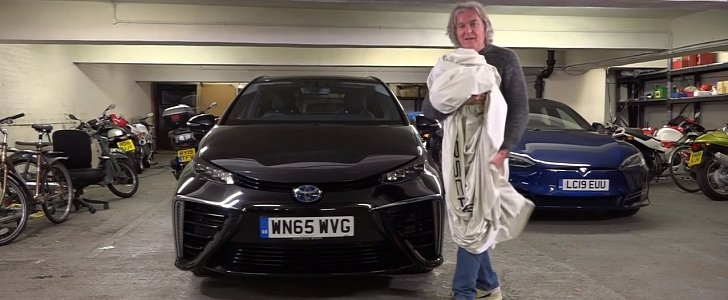After showcasing his all-new Tesla on DriveTribe, the one and only James May returns with another zero-emissions vehicle. The slow tease and Porsche car cover make the start of the video a bit slower than the one starring the Model S 100D, but on the other hand, the wait until the 1-minute 35-second mark is certainly worth it because Mirais are extremely rare cars regardless of market.
“Some of you are going to be very disappointed,” says James immediately after taking the cover off, and in comparison to the straight-line performance of the Tesla, there’s no denying the Toyota is rather boring. But still, don’t forget how different these cars under the skin and in terms of price tag.
First things first, a battery-electric vehicle needs to be charged from a household outlet or a fast-charging station like the Supercharger. The Mirai is a fuel-cell vehicle, built in the Motomachi plant where Lexus used to make the LFA back in the day. A full tank of hydrogen translates to 500 kilometers in one go, and filling ‘er up with the lightest element in the periodic table takes three minutes as opposed to 45 minutes or so for the 100-kWh Model S.
Over in the United Kingdom, £66,000 might seem like a lot for a Toyota running on hydrogen. Another drawback of the Mirai is the H2 infrastructure, dwarfed by the Supercharger network and a few other EV charging stations. The thing is, some believe that hydrogen is the way to go if we desire to reach that zero-emissions utopia the eco-friendly crowd keeps talking about.
Asia’s biggest markets are backing hydrogen and fuel-cell technology in this regard, and Japan is the most important advocate of the hydrogen-fueled society. As a matter of fact, Japan will showcase its ambitions next year at the 2020 Olympics with no fewer than 100 hydrogen buses in Tokyo. In the next six years (2025 included), the plan is to roll out 200,000 hydrogen vehicles on Japanese roads and a lot of hydrogen refueling stations as well.
As the presenter of The Grand Tour says, “the philosophy is very different” between BEVs and FCVs. While hydrogen may seem like a bit of a gamble in this day and age, the carbon-neutral or even carbon-negative future may favor fuel cells over lithium-ion batteries and recharging from the grid.
First things first, a battery-electric vehicle needs to be charged from a household outlet or a fast-charging station like the Supercharger. The Mirai is a fuel-cell vehicle, built in the Motomachi plant where Lexus used to make the LFA back in the day. A full tank of hydrogen translates to 500 kilometers in one go, and filling ‘er up with the lightest element in the periodic table takes three minutes as opposed to 45 minutes or so for the 100-kWh Model S.
Over in the United Kingdom, £66,000 might seem like a lot for a Toyota running on hydrogen. Another drawback of the Mirai is the H2 infrastructure, dwarfed by the Supercharger network and a few other EV charging stations. The thing is, some believe that hydrogen is the way to go if we desire to reach that zero-emissions utopia the eco-friendly crowd keeps talking about.
Asia’s biggest markets are backing hydrogen and fuel-cell technology in this regard, and Japan is the most important advocate of the hydrogen-fueled society. As a matter of fact, Japan will showcase its ambitions next year at the 2020 Olympics with no fewer than 100 hydrogen buses in Tokyo. In the next six years (2025 included), the plan is to roll out 200,000 hydrogen vehicles on Japanese roads and a lot of hydrogen refueling stations as well.
As the presenter of The Grand Tour says, “the philosophy is very different” between BEVs and FCVs. While hydrogen may seem like a bit of a gamble in this day and age, the carbon-neutral or even carbon-negative future may favor fuel cells over lithium-ion batteries and recharging from the grid.












